Evergreens, color, and hardscape carry garden through winter into spring
A recent conversation on Linda Lehmusvirta‘s Facebook page got a few Austin gardeners talking about winter interest. Tracie, a local gardener, wrote that her mostly native garden looks great spring through fall but is “asleep” in winter, and she wanted ideas. Lori at The Gardener of Good and Evil responded by posting year-round views of her Blue Border, showing how evergreens sustain her garden.
I’m joining in by sharing current pictures of my garden, in all its patchy, cut-back, late-winter-on-the-cusp-of-spring glory. While winter is not high season in mine or any garden, I find that three elements keep a garden interesting post-freeze: evergreen plants; color on pots, furnishings, and structures; and defined hardscaping like paths, patios, and walls.
All three are put to use in the pond garden pictured above. ‘Winter Gem’ boxwoods, ‘Color Guard’ yuccas, squid agaves (A. bracteosa), evergreen sumac (Rhus virens), and Texas mountain laurel (Sophora secundiflora) keep the garden in green (and gold) all winter. Blue paint on the shed door, a blue pot fountain, and strongly defined hardscaping continue to attract and lead the eye when flowers have faded away.
At the other end of the garden, which slopes dramatically, retaining walls give structure and line, and a cold-hardy agave and yucca collection is evergreen (and gold and blue-gray) all year. ‘Whale’s Tongue’ agave (A. ovatifolia) anchors the grouping. A bottle tree and blue pots add more color to brighten dreary days.
‘Blue Elf’ aloe is not only evergreen but blooms in late winter/early spring.
In the narrow raised bed behind the house, which I’ve begun to think of as my golden garden, several variegated evergreens keep it “awake” in winter: ‘Alphonse Karr’ bamboo, ‘Bright Edge’ yucca, and ‘Color Guard’ yucca (in the blue pot). In the stock tank, Artemisia ‘Oriental Limelight’ adds to the show in winter and spring, before dying back in our hot, humid summer. In summer, Duranta ‘Sapphire Showers’ will return.
More evergreens hold the winter garden together in the east side path from the front garden to the back: Arizona cypress ‘Blue Ice’ (blue-green tree at left), bamboo muhly grass (at left), gopher plant (in bloom on both sides of the path), ‘Bright Edge’ yucca, ‘Will Fleming’ yaupon holly (columnar tree at right), ‘Green Goblet’ agave, Yucca rostrata ‘Sapphire Skies’, and ‘Winter Gem’ boxwood.
Moving into the front garden, Mediterranean fan palm (Chamaerops humilis) offers lush winter greenery. The Berkeley sedge (Carex divulsa) lawn behind it gets a little yellow but mostly remains green. Low retaining walls add a strong line of hardscape.
Wide-leaf giant hesperaloe (Hesperaloe funifera ssp. chiangii), evergreen with interesting white filaments along the leaf margins, tolerates part shade with ease. I need more groundcovers here though. I tried Jewels of Opar one spring, but the deer ate it. The dormant (maybe dead) plant at right is ‘Wendy’s Wish’ salvia, which I’ll replant if it doesn’t come back. It’s only borderline hardy here but blooms beautifully spring through fall in dappled shade, and deer ignore it.
Another shot of the Berkeley sedge lawn, which is studded with evergreen ‘Margaritaville’ yuccas. A broad decomposed-granite path through the front garden leads to the back gate. Its curving line directs the eye and defines the surrounding beds. I’ve decided to stain the lattice fence a dark gray-green, which will, I hope, make the plants in front of it pop a little more.
Jerusalem sage (Phlomis fruticosa) and paleleaf yucca (Y. pallida), both evergreen, take over on the sunnier side of the garden.
‘Green Goblet’ agave, a curved line of ‘Teresa’ autumn sage (Salvia greggii), and groundcovering woolly stemodia (Stemodia lanata) keep things green all winter in the raised bed near the driveway. The stemodia can get a little ratty by winter’s end, but it greens up quickly in spring.
How about the streetside view? This is actually my neighbor’s garden, which I planted for her. A ‘Whale’s Tongue’ agave will be the centerpiece of this bed as it grows. Cut-back autumn sage is still green, though not showy yet, and Jerusalem sage (Phlomis fruticosa), red yucca (Hesperaloe parviflora), and Mexican feathergrass (Nassella tenuissima) offer year-round color and texture.
Panning right, my own streetside garden is at its quietest, recently shorn of last season’s growth and awaiting spring. Possumhaw holly (Ilex decidua) — caged against deer — is our native deciduous holly. It makes up for losing its leaves with brilliant red berries, which the birds have mostly devoured. In front are autumn sage, catmint, Mexican feathergrass, ‘Pink Flamingos’ muhly grass, and softleaf yucca (Y. recurvifolia) — a mix of evergreens, flowering perennials and sub-shrubs, and grasses selected for deer resistance.
Panning right some more, softleaf yucca, ‘Margaritaville’ yuccas, sedge lawn, and foxtail ferns (Asparagus meyeri) in pots add plenty of winter greenery. The dead grass in the foreground is purple fountain grass, which I replace every spring for its rich, purple foliage.
On the west side of the circular driveway is a more colorful scene thanks to a sprinkling of ‘Color Guard’ yuccas. Gopher plant (Euphorbia rigida), currently in full bloom, echoes their golden stripes. Other evergreens like rosemary, spineless prickly pear (Opuntia), and softleaf yucca keep things green until flowering vitex, copper canyon daisy (Tagetes lemmonii), and majestic sage (Salvia guaranitica) return in spring.
So how do you achieve winter interest in your garden? Or is that something you are working toward?
__________________
I’d love to have your vote in the Better Homes and Gardens 2015 Blogger Awards. Skip through to the Gardening category, select Digging, and then skip to the last page for your vote to be counted. You can vote as much as you like. Thanks for your support!
All material © 2006-2015 by Pam Penick for Digging. Unauthorized reproduction prohibited.


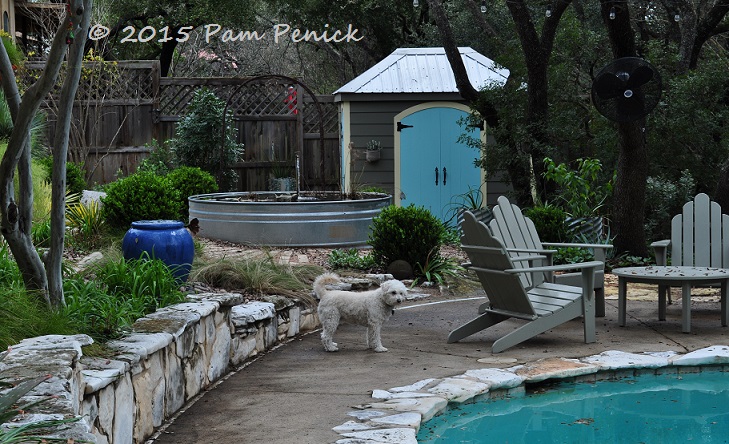
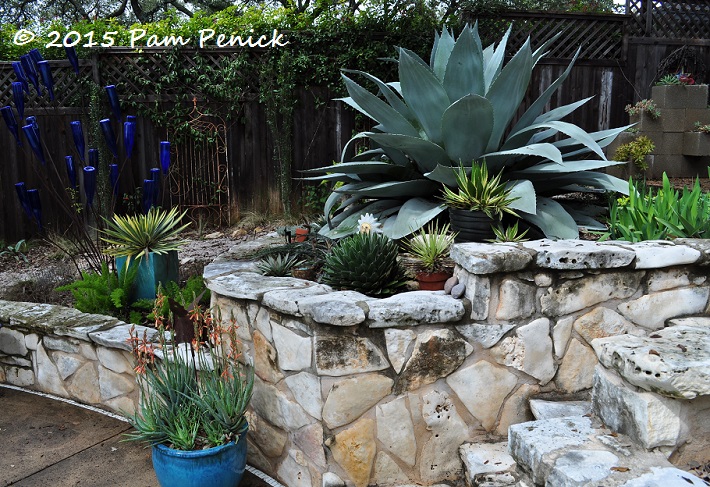
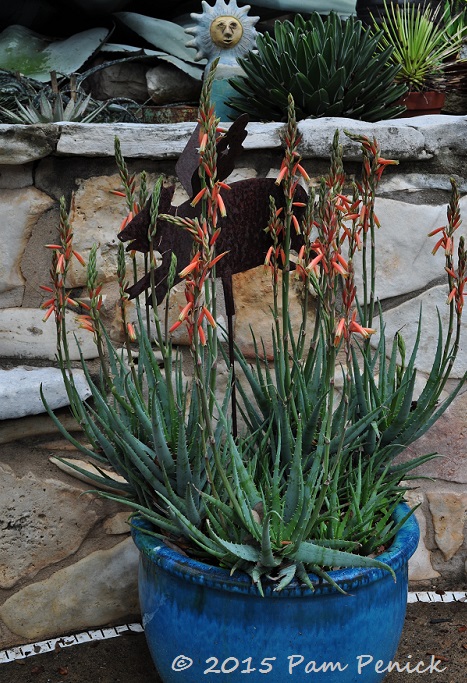
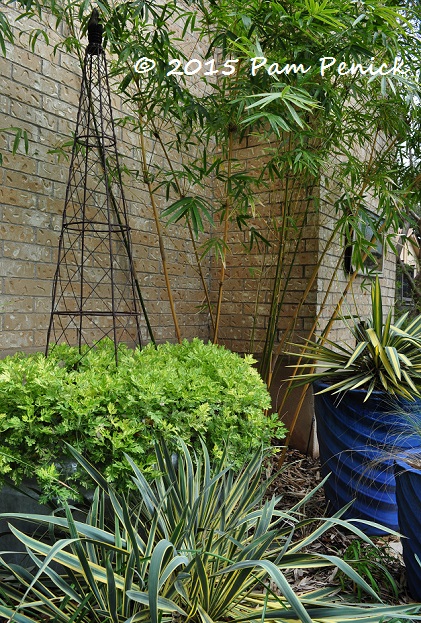
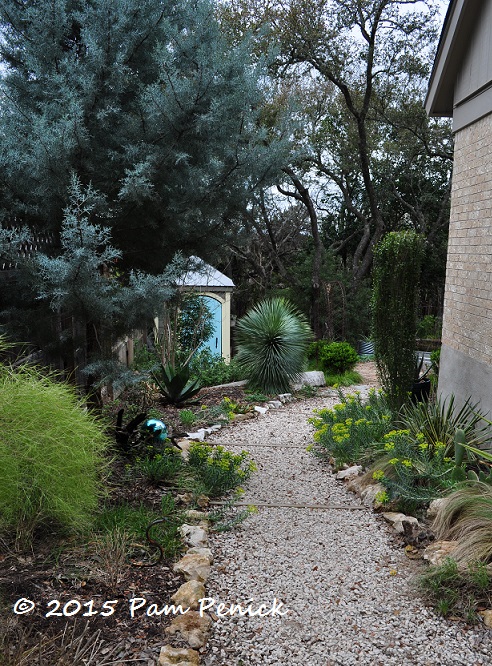
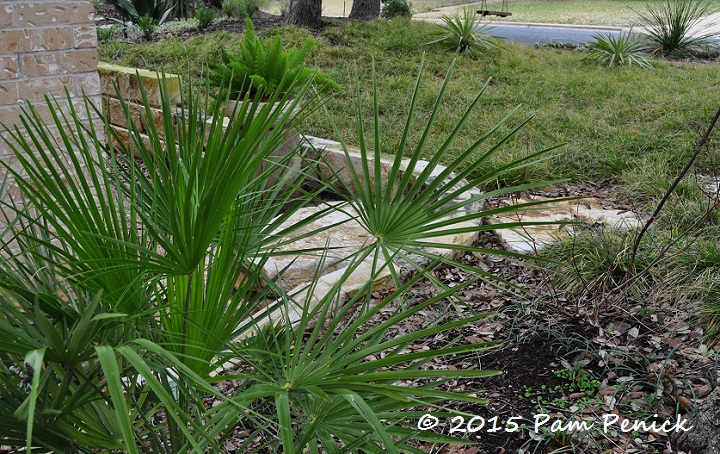
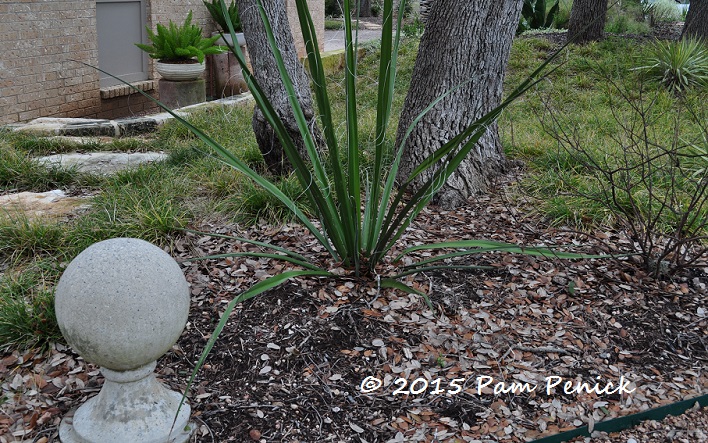
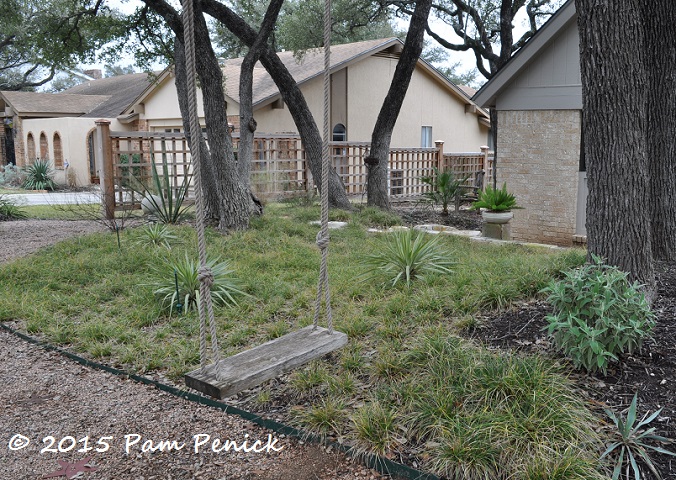
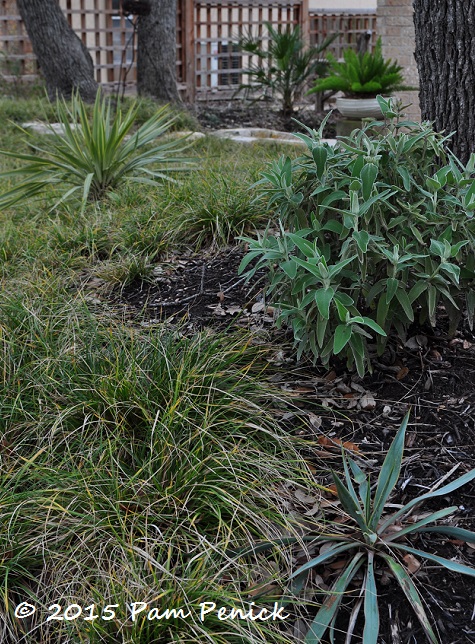
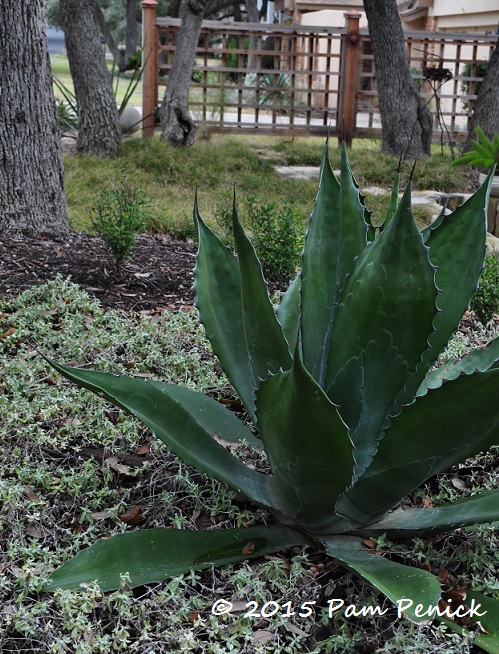
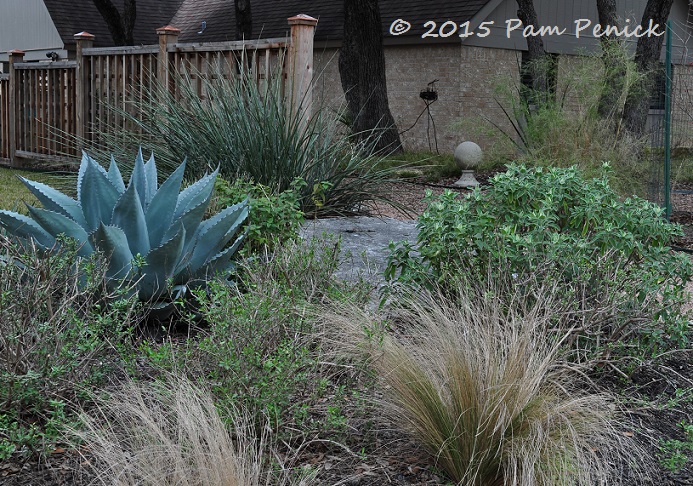
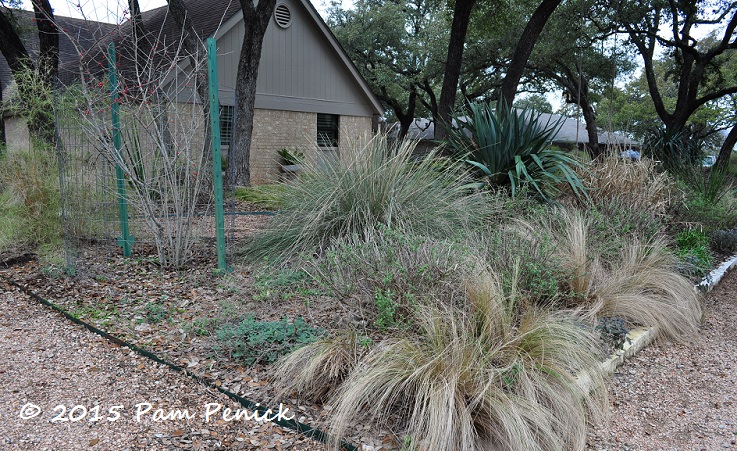
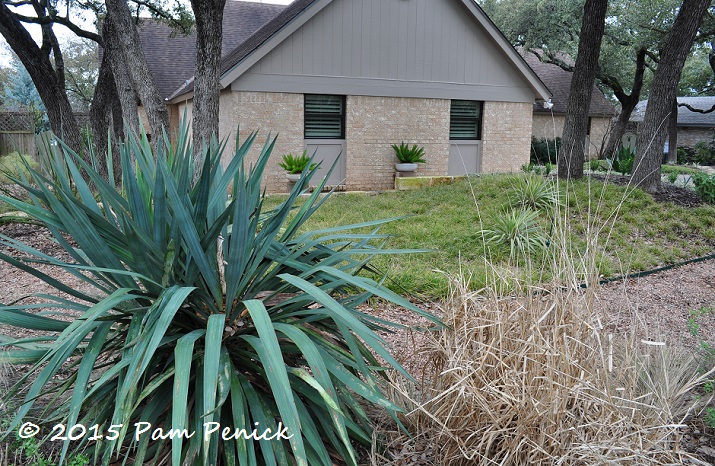
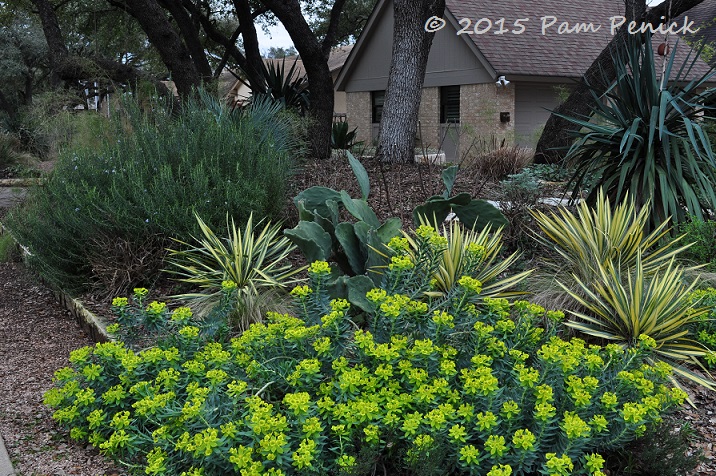
I love that Gopher plant, Pam. Wondering if you found it in Austin?
Looking back at my website I got my gopher plant a year ago at Barton Springs Nursery at pretty much this exact time of year.
Gina, yes, and I often see it at The Natural Gardener and Barton Springs Nursery. It was hard to find a few years ago, but readily available these days. They may not start carrying it until it warms up, but then again Tim says he got his at this time of year. Just give it lots of sun and good drainage. P.S. Is it weird to see your old house with someone else’s garden around it? 🙂 —Pam
Totally. But it does my heart good to see it!
Know that the property is well loved! —Pam
Just bought one yesterday at The Natural Gardener.
I have been working at that for some time. I have splashes of evergreens here and there. I leave tall grass for some tan color. I have a few color guard yuccas too. I am afraid to plant them in the ground because I know they will never be radicated. This is good in some ways but I move things so much, well, I am afraid I would be disappointed. Your garden is a nice mix. Always something to look at. I love that big ole whale.
Thanks, Lisa. I’d be interested to know how winter interest differs between gardens in the South and the colder Midwest. You probably rely less on evergreens and more on deciduous trees and shrubs with interesting bark, berries, and the like? Is your hardscaping largely covered with snow all winter? Evelyn Hadden of Garden Rant wrote a post about winter interest not long ago. Did it resonate with you? —Pam
I think of winter as the time for our lovely live oaks to shine. All the rest of the evergreen larger structure plants take a back seat for a couple of months in winter and my eye tends to be drawn up into those evergreen branches.
More actively, we’ve stopped pruning everything heavily once leaves are dropped or dormancy is obvious. Allowing bare branches to remain in place above mixed ground covers reveals interesting sculptural shapes and structure during times of year when blooms are at a premium.
I’m also working to put in more understory plantings. Once the big fall flourish is history for the year, there will be more ground level interest with differing leaf shapes and colors.
Good points, Deb. And you’re right about the live oaks providing a lot of winter greenery here. I’m glad you’ve reminded me of that benefit because right about now I start grumbling about the live oaks as they drop their leaves for two weeks and then follow up with pollen. Time for the garden to get buried! —Pam
I think your garden looks fabulous in late winter, Pam. Lots of great advice here, too–some of which I can personally use in my garden. Thanks!
Thanks for the nice words, Beth. I’m glad you found the suggestions helpful! —Pam
The sedge lawn is looking fantastic and I love the agave pops!
A woman after my own heart. You know I’m crazy for agaves. 😉 —Pam
I love the combination of the Yucca ‘Color Guard’ and Euphorbia. – I may have to copy that. We don’t have the winter dormancy problem for the most part. Given what appears to by our “new normal” climate, I’m beginning to think that winter is our spring and the rest of the year is summer.
That combo is golden (in every sense) for hot, dry gardens, Kris. I hope it works for you too! —Pam
Love your gardens, Pam. You continually give me lots of wonderful ideas! Do you move or protect the plants in pots during the winter?
Yes, I have a number of small pots of tender succulents that I move indoors whenever a freeze is predicted. They spent a good deal of time indoors this winter! But none of those are pictured in this post. They mostly live on the upper patio, which is above the bed with the ‘Whale’s Tongue’ agave and bottle tree. All of my other potted plants, some of which can be seen in these pics, are both winter hardy (here in zone 8b) and low-water for summer survival. —Pam
Thanks Pam, I like your advice about including hard scape, colorful pots, etc to add winter interest. This is what I was looking for. Most of my yard is “cut back” and “asleep”, but there are buds on the Mountain Laurel so something will be blooming soon! I like the way you and the gardenerofgoodandevil blog too have included large evergreens that do well in our harsh climate. It will be awhile before my evergreens are large, but the colorful flowerpots and hard scape can fill in in the meantime!
I’m glad you found some helpful ideas here, Tracie. You started a really useful discussion, and I enjoyed the ideas everyone has shared. —Pam
That euphorbia shines! And of course you have the best gardening blog! Vote cast.
Aw, thanks, LostRoses! I appreciate your support! —Pam
The 1st photo really shows how to mix in evergreens (and bold pots) to counter brown. But your sedge and spikes area by the swing may be my favorite planting, now…sorry, Moby.
Moby is sulking, David. But he was getting a little fat-headed anyway. I’m a big fan of the sedges and ‘Margaritaville’ yuccas too and must give credit for the idea to Scott and Lauren Springer Ogden, whose Austin garden inspired me. —Pam
Aloes that blaze into bloom are my icon of winter interest. And if I can see snowcapped mountains as well!!